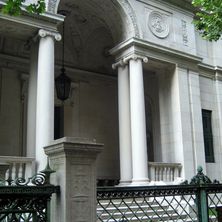

John Pierpont Morgan was one of America's most influential financiers and philanthropists, and like all the 19th century magnates, including Carnegie, Rockefeller and Vanderbilt, often had more control of society than the government itself.
Born in Hartford, Connecticut, after receiving an impeccable education in Europe, J. P. Morgan went to work at his father's banking firm in London. In the middle of 19th century he returned to America and joined another bank. He then teamed up with banker Anthony J. Drexel to form Drexel, Morgan & Company, and after his partner's death, the firm became known simply as J. P. Morgan & Company.
Morgan's specialty was the acquisition of businesses, especially troubled ones, and making them prosperous. He was also skilled at mergers, one of which became the United States Steel Corporation, having fused together three separate companies: the Carnegie Steel Company, the Federal Steel Company and the National Steel Company. When it was founded in 1901, US Steel became the first billion-dollar company in the world.
Although his cutthroat business tactics earned him a lot of enemies and his obscure ties with government institutions often cast a negative light on his image, he was a notable and active philanthropist. Morgan regularly funded institutions such as the Metropolitan Museum of Art, the American Museum of Natural History, which today houses his famous gem collection, Harvard University and Trinity College in the city of his birth, Hartford. Having studied art in his youth, Morgan also had an appreciation for culture, which was demonstrated by his enormous book collection that he left behind in his mansion on Madison Avenue. It was this collection that became the foundation of the Morgan Library & Museum.
The first structure of the library, the one that houses the main collection, was built in 1903 on 36th Street just slightly to the east of Morgan's brownstone residence on Madison Avenue. It became known as the McKim Building, named after the architect, Charles Follen McKim. The entrance has a Palladian arch and two stone lionesses sculpted by Edward Clark Potter, who is better known for the two enormous lions lying at the steps of the New York Public Library on 5th Avenue.
A second stone building was built in 1928 by Benjamin Wistar Morris on the site where the Morgan's residence stood, on the corner of Madison Avenue and 36th Street. In 2006 Italian architect Renzo Piano constructed a glass entrance and hall that connected the Morris building with the library complex's fourth and final structure, a brownish, four-story mansion that served as the New York residence of J. P. Morgan's son, J. P. Morgan, Jr. It was Morgan Junior who opened his father's library to the public in 1924.
The library indeed contains one of the most, if not the most, exquisite collections of manuscripts, bindings, drawings, prints and musical scores in New York. Among the items, the visitor will discover several medieval illuminated manuscripts, that is, manuscripts with ornate initials or illustrations; three Gutenberg Bibles, original manuscripts and notebooks belonging to Sir Walter Scott, Lord Byron, George Sand, Robert Burns ; original scores by Mozart, Verdi, Mahler, Chopin, Brahms and Beethoven; and drawings by Da Vinci, Raphael, Michelangelo, Rembrandt, Rubens, Durer, Cezanne, van Gogh and Picasso.
The Morgan Library and Museum's first director was the twenty-five-year-old Belle da Costa Greene, an African American beauty whose father had been the first African American to graduate from Harvard University. She was an intelligent and sophisticated socialite and wielded a lot of influence among international art collectors. When the seventy-five-year-old J. P. Morgan died in 1913, he left his librarian $50,000, which today would be almost $1 million. This legacy prompted many to wonder if Greene had been Morgan's mistress. Once she even deigned to respond: "There were attempts."